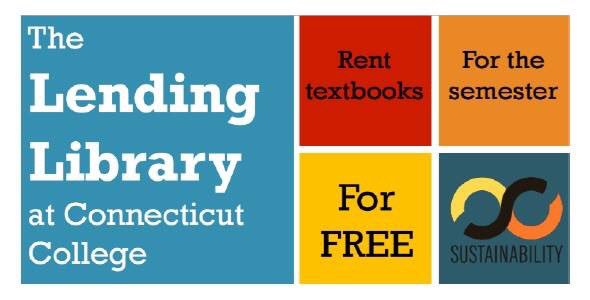College students are well-versed in the woes of being strapped for cash. The cost of enrollment alone is enough to empty one’s wallet, but the myriad of extra expenses that come along with college throw more salt in the wound. Among the worst of these costs is something essential: books. Very little tops the feeling of dread in a student’s stomach as they check the textbook requirements for their next semester classes and see nothing but dollar signs stacking up. Even renting can add up to a shockingly expensive total. Conn, however, has a solution to help students manage their textbook expenses, and it comes in the form of the Lending Library.
Tucked away into closets in Katharine Blunt and Burdick are the Lending Library’s collection of books, built up since 2013 via student donations. All of these books are specific to various classes that have been taught at Conn, and students can check them out at absolutely zero cost at the beginning of each new semester. One of the more notable aspects of this program, however, is that it is almost entirely a student-driven initiative.
“It’s basically all student run,” confirmed Margaret Bounds, Assistant Director of Sustainability at Conn. She cited the Office of Sustainability Fellows Emma Brooks, Grace Berman, Lera Shynkarova, and Rebecca Brill Weitz as being integral to the program’s success in recent times. “I only really help when I need to fill in shifts here and there…but basically students run [the Lending Library],” said Bounds. Berman confirmed that this is mostly a for-students, by-students organization, saying “It’s been a hands-on project… the main push is definitely from the students. The sustainability heads have been really supportive.”
Clearly, these students have been running the program well. According to a presentation recently delivered by the Office of Sustainability at the 2017 Association for the Advancement of Sustainability in Higher Education (AASHE) Conference, the Lending Library has amassed a truly impressive following on campus that has only grown in recent years. In 2016, there were 50 students who utilized the books offered by the Lending Library. By fall semester of 2017, this number had almost tripled to 140 students, and, according to the calculations of the Lending Library staff, those students saved a combined total of $21,014 on their textbooks for that semester. This undoubtedly impressive statistic is all a result of the hard work that students such as Brooks, Berman, Shynkarova, and Brill Weitz have dedicated towards its development.
Even though the Lending Library program has achieved much, it doesn’t seem likely that it’ll simply rest on its laurels for too long. Just earlier this semester, the Library staff succeeded in filing all of the books into an online catalogue to make it easier for students to search for the textbooks they need. Beyond this, the staff at the Library and the Office of Sustainability have no shortage of plans for expanding the program in the future.
“We’re actually putting barcodes on all of the books right now,” said Bounds, “so far we’ve done ‘A’ through ‘E.’” In doing this, the staff hopes to better be able to handle and organize multiple copies of the same book, much like a traditional library.
With improvements like this in the near future, Berman expressed her hope that student use of the Lending Library will surpass the numbers it achieved this past semester. “So many people will come to us like, ‘I never knew this existed’,” she said, adding that she hopes the new accessibility tools such as the online catalogue and an app that lets students check books out from their phones will spread the awareness of all the Lending Library has to offer.
Both Berman and Bounds stressed that the Lending Library only exists as a result of the generosity of Conn students—and not just the ones who volunteer their time there. “Mainly, the books are donations,” said Bounds, “I know obviously you want to sell [a book] back if you can, but if you don’t need the money and can donate it, that’s great.” This project has already saved students an impressive sum over its short existence, and with the support of the community, it appears that the Lending Library will continue that trend for semesters to come.










